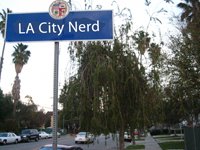 With the latest proposal from the City Council to repair 4,000 City streets via an $1.5 billion bond over eight years, I thought I'd explain, as briefly as possible, what the current way a street is resurfaced. For this case study, let's pick a street in Mar Vista: Barry Drive between Venice Boulevard and Victoria. This is a fairly standard street (unlike one block north where there is a center median in the residential neighborhood).
With the latest proposal from the City Council to repair 4,000 City streets via an $1.5 billion bond over eight years, I thought I'd explain, as briefly as possible, what the current way a street is resurfaced. For this case study, let's pick a street in Mar Vista: Barry Drive between Venice Boulevard and Victoria. This is a fairly standard street (unlike one block north where there is a center median in the residential neighborhood). So, the first thing to understand is that there are a few types of streets: Highways (Highland), Secondary Highways (Venice Boulevard), Collector Streets(Franklin Avenue east of Western), and Local Streets (Barry). Each type of street has different funding sources available to it - local streets having the least available outside the general fund. For instance, Secondary Highways, which are normally transportation corridors (buses run on them) are eligible for "Prop C" funds, whereas local streets are not.
Also, to understand the equation, know that streets, regardless of transportation designation, fall into three condition categories: those needing complete reconstruction (failed streets), those needing regular traditional resurfacing(removal of about 3 inches of roadway), and those that need a maintenance overlay (remove about an inch). Additionally, in order to extend the life of a street, streets that are about years old will get a slurry seal, which can extend the life of the street for decades if the seal is re-applied systematically. With each increasing level of street decay, the cost of fixing the street goes up. Also, extremely wide streets, hillside streets, and concrete streets have additional costs.
So, back to Barry Drive...
Let's say a resident calls in to request that their street be repaired. They could call the Department of Public Works, their Councilman's office, or take their concern to the Mar Vista Neighborhood Council. The Department will take the request and put them at the bottom of a very long list of requests that have come in over the years. Councilman Rosendahl may decide to bump you up on the list depending how many of your neighbors complain and how organized your campaign is to get your street repaired. (Often times in this situation, the squeaky wheel gets the oil more times than not!) The Neighborhood Council also has influence (if they choose to use it) as well as an allocation of $100K per year directly towards deciding what streets should be repaired. (for $100K, you can get about 4 blocks of regular resurfacing, depending how bad the street, maybe one block of reconstruction, and about 8 blocks of slurry seal). Again, organizing an effort and putting pressure on the Councilman, right now, is the best way to get your street repaired. And if the councilman decides Barry is on the plan for next year, it is contingent on the Mayor's budget funding enough repair to include Barry along with all the other important, committed projects.
NOTE: A councilman may direct it to be the next street on the list, but if their is a utility that says they will do work there in the next year, the City must defer the street. This is what's called a Utility Hold. Whenever a street is selected to be repaired, over 100 utilities that have easements under the City Streets are notified and can request a hold so that they can complete their work. This is done to prevent a freshly resurfaced street from being cut open. Even when repaired, cuts in the street surface are the largest contributor to the degradation of the street condition.
Sadly, the process right now is political. The Councilman has his allocation that he literally directs as to what streets should be included in the resurfacing program.
All this information (and more) can be found at the Bureau of Street Services website. I would take the time to look at this presentation to fully understand the trends and reasons we're in the situation where the council claims the City needs a bond.


2 comments:
Thanks for posting this information! The street in front of my house had the top couple of inches scraped off a week ago by the Department of Public Works. I was wondering why it wasn't one of the other agencies that do work on L.A.'s streets.
Any idea how much the city pays for slurry seal by square foot?
Post a Comment